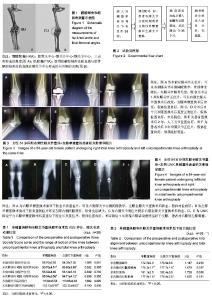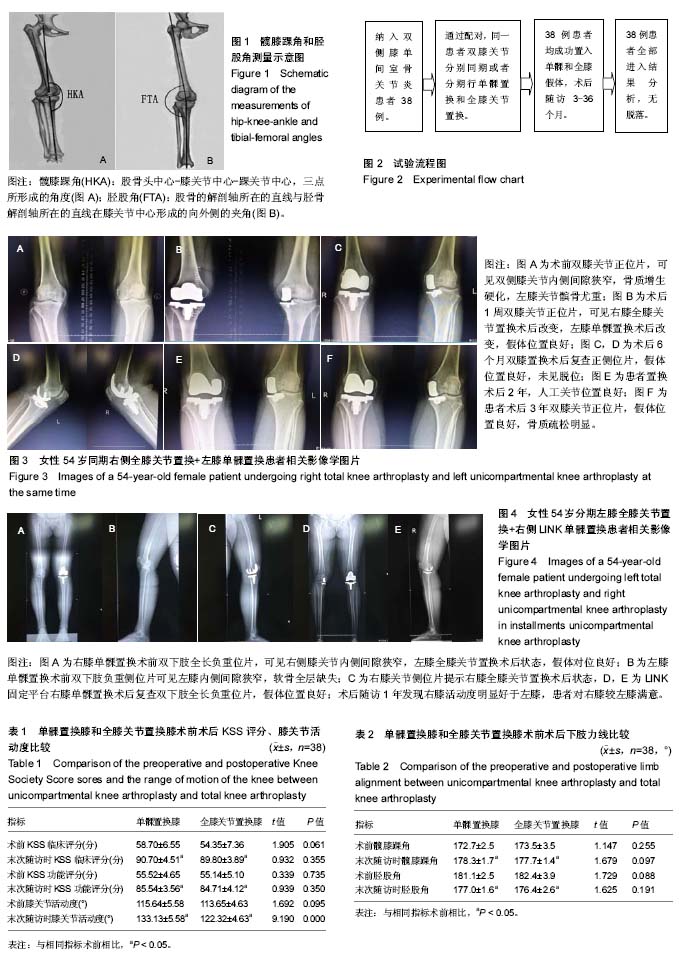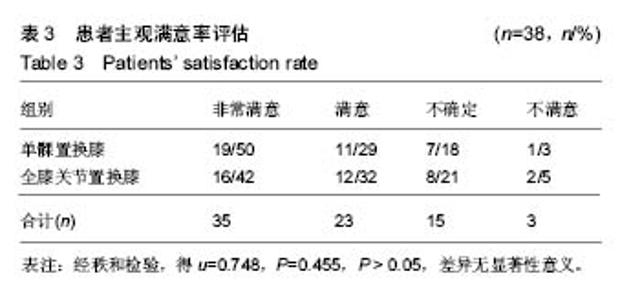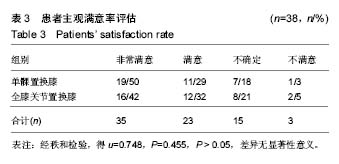Chinese Journal of Tissue Engineering Research ›› 2018, Vol. 22 ›› Issue (3): 343-349.doi: 10.3969/j.issn.2095-4344.0028
Previous Articles Next Articles
Unicompartmental knee arthroplasty versus total knee arthroplasty in the same patient with bilateral unicompartment knee osteoarthritis
Lu Ming-feng1, Li Ze-hui2, Zhu Dong-ping1, Cao Xue-wei2, Niu Wei2
- 1Clinical Medical School of Guangzhou University of Chinese Medicine, Guangzhou 510403, Guangdong Province, China; 2Third Department of Orthopedics, Guangdong Provincial Hospital of Chinese Medicine, Guangzhou 510120, Guangdong Province, China
-
Online:2018-01-28Published:2018-01-28 -
Contact:Cao Xue-wei, Chief physician, Third Department of Orthopedics, Guangdong Provincial Hospital of Chinese Medicine, Guangzhou 510120, Guangdong Province, China -
About author:Lu Ming-feng, Studying for master’s degree, Clinical Medical School of Guangzhou University of Chinese Medicine, Guangzhou 510403, Guangdong Province, China -
Supported by:the National Natural Science Foundation of China, No. 81473700; the Guangdong Provincial Department of Science and Technology, No. 2014KT1508; the Chaoyang Talents of Guangdong province, No. 2014KT1479; the Traditional Chinese Medicine Bureau of Guangdong Province, No. 2017KT1117
CLC Number:
Cite this article
Lu Ming-feng, Li Ze-hui, Zhu Dong-ping, Cao Xue-wei, Niu Wei. Unicompartmental knee arthroplasty versus total knee arthroplasty in the same patient with bilateral unicompartment knee osteoarthritis [J]. Chinese Journal of Tissue Engineering Research, 2018, 22(3): 343-349.
share this article
Add to citation manager EndNote|Reference Manager|ProCite|BibTeX|RefWorks

2.1 参与者数量分析 按意向性处理,纳入同一患者膝单间室关节炎单髁置换和全膝关节置换治疗的患者38例,术后全部获得随访,无脱落。试验流程图见图2。 2.2 随访时间及不良事件 术后随访3-36个月,所有病例双膝均未发生无菌性假体松动、不明原因疼痛等并发症。 2.3 总体疗效比较 单髁置换膝与全膝关节置换膝KSS临床评分均比术前明显升高(P < 0.05);术前单髁置换膝和全膝关节置换膝KSS临床评分相比差异无显著性意义(t=1.905 1,P > 0.05);单髁置换膝和全膝关节置换膝末次随访KSS临床评分相比,差异亦无显著性意义(t=0.931 5,P > 0.05); 单髁置换膝与全膝关节置换膝KSS功能评分均比术前明显升高(P < 0.05);术前单髁置换膝和全膝关节置换膝KSS功能评分相比差异无显著性意义(t=0.339,P > 0.05);单髁置换膝和全膝关节置换膝末次随访KSS功能评分相比,差异亦无显著性意义(t=0.939,P > 0.05);单髁置换能获得比全膝关节置换膝更大的膝关节活动度,术后末次随访时单髁置换膝和全膝关节置换膝活动度差异有显著性意义(t=9.190,P < 0.05),见表1。 下肢力线均得到矫正,术前术后单髁置换膝和全膝关节置换膝胫股角和髋膝踝角比较,差异均无显著性意义 (P > 0.05),见表2。 20例患者觉得偏爱单髁置换,18例患者偏爱全膝关节置换;大部分患者对于置换术后双膝感觉满意或者非常满意,见表3。 2.4 同一患者双膝同期及分期手术的疗效比较 本组患者双膝同期置换10例,分期置换28例。根据统计(表4),同期与分期行单髁和全膝置换的患者术后末次随访时KSS临床评分、KSS功能评分、膝关节活动度、髋膝踝角、胫股角相比较,差异均无显著性意义(P > 0.05)。 2.5 典型病例 典型病例1:女性患者,54岁,双膝疼痛、活动受限10余年,加重3个月,左膝内侧单间室、髌骨关节疼痛明显,右膝以内侧疼痛为主,行同期右侧全膝关节置换术+左膝单髁置换术,双侧下肢力线矫正角度好,术后患者右膝关节伸直和屈曲较左膝差,患者对左膝单髁置换较满意,见图3。 典型病例2:女性患者,54岁,双膝疼痛、活动受限5余年,加重1个月,左膝行全膝关节置换,右侧LINK单髁置换术,分期手术。双侧下肢力线矫正角度好,术后患者左膝关节伸直和屈曲较右膝差,患者对右膝单髁置换较满意,见图4。 "

| [1] Arirachakaran A,Choowit P,Putananon C,et al.Is unicompartmental knee arthroplasty(UKA) superior to total knee arthroplasty (TKA)? A systematic review and meta-analysis of randomized controlled trial.Eur J Orthop Surg Traumatol. 2015; 25(5):799-806.[2] Niinimaki T,Eskelinen A,Makela K,et al.Unicompartmental knee arthroplasty survivorship is lower than TKA survivorship: a 27-year Finnish registry study.Clin Orthop Relat Res.2014;472(5): 1496-1501.[3] Liddle AD,Pandit H,Judge A,et al. Patient-reported outcomes after total and unicompartmental knee arthroplasty: a study of 14,076 matched patients from the National Joint Registry for Englandand Wales.Bone Joint J.2015; 97(6):793 -801.[4] Faour Martín O,Valverde García JA,Martín Ferrero MA,et al. The young patient and the medial unicompartmental knee replacement.Acta Orthop Belg. 2015;81(2):283-288.[5] Arno S,Maffei D,Walker S,et al.Retrospective analysis of total knee arthroplasty cases for visual,histological,and clinical eligibility of unicompartmental knee arthroplasties. J Arthroplasty. 2011;26(8):1396-1403.[6] 张启栋,郭万首,刘朝晖,等.内翻畸形膝骨关节炎软骨磨损的临床研究[J]. 中国矫形外科杂志,2013,21(23) :2345-2350..[7] 陈百成,张静.骨关节炎[M].北京:人民卫生出版社,2004:18-20.[8] Ewald FC.The Knee Society total knee arthroplasty roentgenographic evaluation and scoring system. Clin Orthop Relat Res. 1989;11(248):9-12.[9] 胡承方.国人胫骨近端形态学测量与研究[D].上海:上海交通大学, 2007.[10] Kyung T.Song L,Hoon S, et al. Unicompartmental versus Total Knee Arthroplasty in the Same Patient. J Korean Orthop Assoc. 2008;43(1): 451-457[11] 袁毅,马川,黄家俊.膝关节骨性关节炎的治疗进展[J].西部医学,2011. 23(8):1600-1602.[12] 刘晓东,蔡珉巍,涂意辉.微创单髁置换术治疗膝关节内侧间室骨性关节炎的初步临床报告[J].中国矫形外科杂志, 2010,18(7):548-552.[13] Koskinen E, Eskelinen A, Paavolainen P, et al. Comparison of survival and cost-effectiveness between unicondylar arthroplasty and total knee arthroplasty in patients with primary osteoarthritis: a follow-up study of 50,493 knee replacements from the Finnish Arthroplasty Register. Acta Orthop. 2008;79(4):499-507.[14] Amin AK, Patton JT, Cook RE, et al. Unicompartmental or total knee arthroplasty?:Results from a matched study. Clini Orthop Relat Res. 2006;451(10):101-106.[15] 唐恒涛,赵亮,燕华,等. OxfordⅢ单髁系统治疗膝关节内侧间室退变的中期疗效[J].中国修复重建外科杂志,2012.26(12):17-20.[16] National Joint Registry for England ,Wales,Northern and the Isle of Man .13th annualreport2016.2016. http://www.njrcentre.org.uk/njrcentre/Portals/0/Documents/England/Reports/13th-annual_report/NJR%2016th%20Annual%20Report%202016%20B.pdf. Accessed 2015 Dec 31.[17] Hamilton WG,Ammeen DJ,Hopper RH.Mid-term survivorship of minimally invasive unicompartmental arthroplasty with a fixedbearing implant: revision rate and mechanisms of failure. J Arthroplasty. 2014;29(5):989-992.[18] Foran JR,Brown NM,Della Valle CJ,et al.Long-term survivorship and failure modes of unicompartmental knee arthroplasty. Clin Orthop Relat Res. 2013;471(1):102-108.[19] Parratte S,Ollivier M,Lunebourg A,et al. Long-term results of compartmental arthroplasties of the knee: Long term results of partial knee arthroplasty. Bone Joint J. 2015;97b(10 SupplA): 9-15.[20] Soohood NF,Sharifi H,Kominski G,et al.Costefeetiveness analysis of unicompartmental knee arthroplasty as an alternative to total knee arthroplasty for unicompartmental osteoarthritis.J Bone Joint Surg Am. 2006;88(9):1975-1982.[21] Maduekwe UI, Zywiel MG, Bonutti PM, et al. Scientific evidence for the use of modern unicompartmental knee arthroplasty. Expert Rev Med Devices. 2010;7(2):219-239.[22] 刘志宏,张炅,何川,等.活动平台全膝关节假体和单髁膝关节假体置换术后的步态对比分析[J].中华关节外科杂志(电子版), 2017,11(1): 17-23.[23] Jones GG, Kotti M ,Wiik AV,et al.Gait comparison of unicompartmental and total knee arthroplasties with healthy controls.Bone Joint J. 2016;98-B(10 Suppl B):16-21.[24] Maduekwe UI, Zywiel MG, Bonutti PM, et al. Scientific evidence for the use of modern unicompartmental knee arthroplasty. Expert Rev Med Devices. 2010;7(2):219-239.[25] Argenson MD,Guillaume blanc MD,et al.Modern unicompartmental knee arthroplasty with cement:a concise follow-up at a mean of twenty years of a previous report. J Bone Joint Surg Am. 2013;95(10):905-909.[26] Zuiderbaan HA, van der List JP, Khamaisy S, et al. Unicompartmental knee arthroplasty versus total knee arthroplasty: Which type of artificial joint do patients forget? Knee Surg Sports Traumatol Arthrosc. 2015;21(11):1007-1013.[27] Dalury DF, Fisher DA, Adams MJ, et al. Unicompartmental knee arthroplasty compares favorably to total knee arthroplasty in the same patient. Orthopedics. 2009;32(4):253-257.[28] Laurencin CT, Zelicof SB, Scott RD, et al. Unicompartmental versus total knee arthroplasty in the same patient.A comparative study. Clin Orthop Relat Res. 1991;273(2):151-156.[29] Longo UG, Loppini M, Trovato U, et al. No difference between unicompartmental versus total knee arthroplasty for the management of medial osteoarthtritis of the knee in the same patient: a systematic review and pooling data analysis. Br Med Bull. 2015;114(1):65-73.[30] Costa CR, Johnson AJ, Mont MA, et al. Unicompartmental and total knee arthroplasty in the same patient.J Knee Surg. 2011; 24(4):273-278.[31] Hunt LP, Ben-Shlomo Y, Clark EM, et al. 45-day mortality after 467 779 knee replacements for osteoarthritis from the National Joint Registry for England and Wales: an observational study. Lancet. 2014;384:1429-1436.[32] Liddle D,Judge A,Pandit H,et al. Adverse outcomes after total and unicompartmental knee replacement in 101,330 matched patients: a study of data from the National Joint Registry for England and Wales. Lancet. 2014;384(9952):1437-1445..[33] Murray DW,Liddle AD,Judge A, et al. Bias and unicompartmental knee arthroplasty. Bone Joint J. 2017;99 (1):12-15.[34] Atsuo I,Yuji A, Shuji N. Comparison of alignment correction angles between fixed-bearing and mobile-bearing UKA. J Arthroplasty. 2016; 31(1):142-145.[35] Sardana V, Burzynski JM, Khan M, et al. Long-term functional outcomes and knee alignment of computerassisted navigated total knee arthroplasty. Musculoskelet Surg. 2017;101(1):37-43.[36] Schiraldi M, Bonzanini G, Chirillo D, et al. Mechanical and kinematic alignment in total knee arthroplasty. Ann Transl Med. 2016;4(7):130. |
| [1] | Zhang Tongtong, Wang Zhonghua, Wen Jie, Song Yuxin, Liu Lin. Application of three-dimensional printing model in surgical resection and reconstruction of cervical tumor [J]. Chinese Journal of Tissue Engineering Research, 2021, 25(9): 1335-1339. |
| [2] | Zhang Yu, Tian Shaoqi, Zeng Guobo, Hu Chuan. Risk factors for myocardial infarction following primary total joint arthroplasty [J]. Chinese Journal of Tissue Engineering Research, 2021, 25(9): 1340-1345. |
| [3] | Li Dadi, Zhu Liang, Zheng Li, Zhao Fengchao. Correlation of total knee arthroplasty efficacy with satisfaction and personality characteristics [J]. Chinese Journal of Tissue Engineering Research, 2021, 25(9): 1346-1350. |
| [4] | Wei Wei, Li Jian, Huang Linhai, Lan Mindong, Lu Xianwei, Huang Shaodong. Factors affecting fall fear in the first movement of elderly patients after total knee or hip arthroplasty [J]. Chinese Journal of Tissue Engineering Research, 2021, 25(9): 1351-1355. |
| [5] | Wang Jinjun, Deng Zengfa, Liu Kang, He Zhiyong, Yu Xinping, Liang Jianji, Li Chen, Guo Zhouyang. Hemostatic effect and safety of intravenous drip of tranexamic acid combined with topical application of cocktail containing tranexamic acid in total knee arthroplasty [J]. Chinese Journal of Tissue Engineering Research, 2021, 25(9): 1356-1361. |
| [6] | Xiao Guoqing, Liu Xuanze, Yan Yuhao, Zhong Xihong. Influencing factors of knee flexion limitation after total knee arthroplasty with posterior stabilized prostheses [J]. Chinese Journal of Tissue Engineering Research, 2021, 25(9): 1362-1367. |
| [7] | Huang Zexiao, Yang Mei, Lin Shiwei, He Heyu. Correlation between the level of serum n-3 polyunsaturated fatty acids and quadriceps weakness in the early stage after total knee arthroplasty [J]. Chinese Journal of Tissue Engineering Research, 2021, 25(9): 1375-1380. |
| [8] | Zhang Chong, Liu Zhiang, Yao Shuaihui, Gao Junsheng, Jiang Yan, Zhang Lu. Safety and effectiveness of topical application of tranexamic acid to reduce drainage of elderly femoral neck fractures after total hip arthroplasty [J]. Chinese Journal of Tissue Engineering Research, 2021, 25(9): 1381-1386. |
| [9] | Yuan Jiawei, Zhang Haitao, Jie Ke, Cao Houran, Zeng Yirong. Underlying targets and mechanism of Taohong Siwu Decoction in prosthetic joint infection on network pharmacology [J]. Chinese Journal of Tissue Engineering Research, 2021, 25(9): 1428-1433. |
| [10] | Chen Junming, Yue Chen, He Peilin, Zhang Juntao, Sun Moyuan, Liu Youwen. Hip arthroplasty versus proximal femoral nail antirotation for intertrochanteric fractures in older adults: a meta-analysis [J]. Chinese Journal of Tissue Engineering Research, 2021, 25(9): 1452-1457. |
| [11] | Huang Dengcheng, Wang Zhike, Cao Xuewei. Comparison of the short-term efficacy of extracorporeal shock wave therapy for middle-aged and elderly knee osteoarthritis: a meta-analysis [J]. Chinese Journal of Tissue Engineering Research, 2021, 25(9): 1471-1476. |
| [12] | Zeng Yanhua, Hao Yanlei. In vitro culture and purification of Schwann cells: a systematic review [J]. Chinese Journal of Tissue Engineering Research, 2021, 25(7): 1135-1141. |
| [13] | Zhong Hehe, Sun Pengpeng, Sang Peng, Wu Shuhong, Liu Yi. Evaluation of knee stability after simulated reconstruction of the core ligament of the posterolateral complex [J]. Chinese Journal of Tissue Engineering Research, 2021, 25(6): 821-825. |
| [14] | Zhao Zhongyi, Li Yongzhen, Chen Feng, Ji Aiyu. Comparison of total knee arthroplasty and unicompartmental knee arthroplasty in treatment of traumatic osteoarthritis [J]. Chinese Journal of Tissue Engineering Research, 2021, 25(6): 854-859. |
| [15] | Liu Shaohua, Zhou Guanming, Chen Xicong, Xiao Keming, Cai Jian, Liu Xiaofang. Influence of anterior cruciate ligament defect on the mid-term outcome of fixed-bearing unicompartmental knee arthroplasty [J]. Chinese Journal of Tissue Engineering Research, 2021, 25(6): 860-865. |
| Viewed | ||||||
|
Full text |
|
|||||
|
Abstract |
|
|||||



